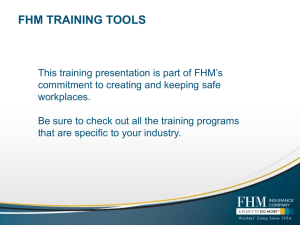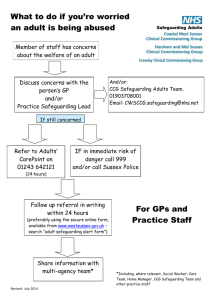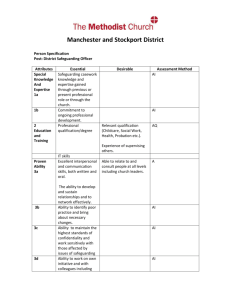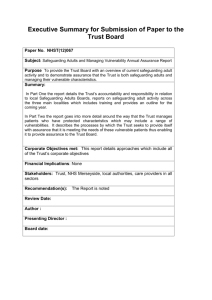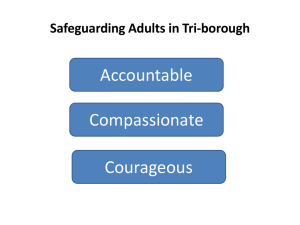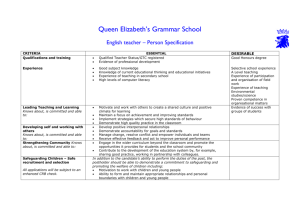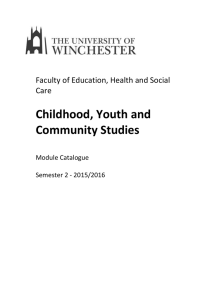Chapter 24 Cold Forming of Metals
advertisement
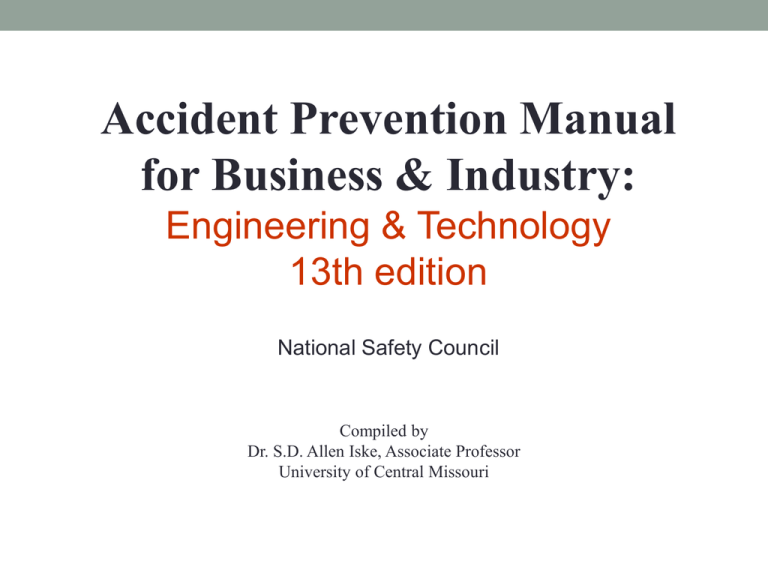
Accident Prevention Manual for Business & Industry: Engineering & Technology 13th edition National Safety Council Compiled by Dr. S.D. Allen Iske, Associate Professor University of Central Missouri CHAPTER 24 COLD FORMING OF METALS Cold Forming of Metals • Cold forming: The forming of blank metal into a shape. • A variety of machines can be used for this operation depending on the metal and desired end product. • Common machines used for cold forming include power presses, metal shears, and press breaks. Power Presses • Versatile machines that can be attached with different dies to produce a variety of products • Safeguarding the point of operation of a press depends on • • • the die or tool component type of press selected to power the die method selected to insert materials, to remove parts, and to dispose of scrap Power Presses (Cont.) • Die or tool component design considerations: • material used • configuration of the finished part • method of feeding the material • method of removing parts • method of scrap disposal • ways to reduce noise Power Presses (Cont.) • The safety of power press operations depends on: • adequately safeguarding the point of operation • properly training press operators • enforcing safe work practices • Setup and maintenance personnel must be trained to assure their s.afety while working in or around a press Power Presses (Cont.) • Operations are either primary or secondary • Primary operations (blanking)—stock material is processed to produce suitably sized and shaped flat blanks • easier to guard than secondary operations • Secondary operations—further forming and shaping of blanks Primary Operations • Hazards include: • die setup • guard repairs • material handling • feeding stock into machines • part and scrap ejection Secondary Operations • Adaptable for various feeding methods: • manual feed • gravity feed • follow or push feed • magazine feeds Secondary Operations (Cont.) • Tools • Hand tools are useful when parts must be placed or removed manually. • Cleaning and prying tools are essential for cleaning dies and clearing jams. • Simple and safe hand tools, which can be made, can save the hands and fingers of operators. Secondary Operations (Cont.) Secondary Operations (Cont.) • Safeguarding • The safeguarding program should be based on an evaluation of the specific problems. • Formulate a definite company policy that covers: • use of guards or devices for all operations. • consideration of the safety factor in new operations. • enforcement of safe operating standards. Secondary Operations (Cont.) Definitions • Antirepeat: the part of the clutch/break control system • • • • designed to limit the press to a single stroke if the actuating means is held or stuck on “operate”. Bolster plate: plate attached to the top of the bed of the press component where lower die or die shoes are attached. Brake: mechanism on a mechanical power press component to stop and/or hold the slides. Single atroke: one complete stroke of the slide, usually initiated from a full-open position, followed by closing, and then returned to the full-open position. Slide: the main reciprocating press component member; a slide may be called a ram, plunger, head, or platen. Definitions (Cont.) • Inch: an intermittent motion imparted to the slide by momentary operation of the inch-operating means. • Full-revolution clutch: a type of clutch that, when tripped, cannot be disengaged until the drive mechanism has completed a full revolution and the slide, a full stroke. • Part-revolution clutch: a type of clutch that can be disengaged at any point before the drive mechanism has completed a full revolution and the press slide, a full stroke. • Direct drive: type of drive arrangement wherein no clutch is used; they match the operational characteristics of part revolution clutches because the driving power may be disengaged during the stroke of the slide. Point-of-Operation Safeguarding • Protecting personnel, including helpers, after the dies have been installed, tested, and operated, and are ready for production • Consider all hazards in the die’s space that may crush, cut, punch, sever, or otherwise injure personnel. • There are two basic categories of safeguarding at the point of operation: • the guard • the device Point-of-Operation Safeguarding (Cont.) • A guard, or barrier guard, is a physical barrier that prevents access to a die’s hazard during operation • If a barrier allows access to a die’s hazard during operation, it is not a guard; it is an inadequate enclosure. • An inadequate enclosure always requires using a device to form an acceptable safeguarding system. Point-of-Operation Safeguarding (Cont.) • There are four main types of guards for safeguarding power presses. • fixed die-enclosure guards—complete protection for the operator • fixed-barrier guards • interlocked press-barrier guards • adjustable-barrier guards Point-of-Operation Safeguarding (Cont.) Point-of-Operation Safeguarding (Cont.) Point-of-Operation Safeguarding (Cont.) • A safeguarding device controls access to the point of operation. • Devices can be divided into three categories: • press-controlling devices • operator-controlling devices • devices that control both the operator and the power press Point-of-Operation Safeguarding (Cont.) • There are several types of safeguarding devices for power presses: • Type-A, moveable-barrier device • protects by enclosing the point of operation before a press stroke begins • Type-B, moveable-barrier device • not suitable for full revolution machines • Two-hand tripping devices • used on a full-revolution clutch machine Point-of-Operation Safeguarding (Cont.) Point-of-Operation Safeguarding (Cont.) • There are several types of safeguarding devices for power presses: • Two-hand control devices • Regulatory standards may specify safe distance for mounting controls. • Pull-back devices • Usually limited to secondary operations. • Restraints • Presence sensing devices Safeguarding Full-Revolution Clutch Power Presses • Guards • fixed die-enclosure guard • fixed-barrier guard • adjustable-barrier guard • Devices • restraints, properly adjusted • pull-backs, properly adjusted • type-A, movable barrier, with an enclosure to prevent access through areas not protected by the movable barrier • two-hand tripping, located at a distance that exceeds the safe distance for the particular press Safeguarding Partial-Revolution Clutch Power Presses • Guards • fixed die-enclosure guard • fixed-barrier guard • adjustable-barrier guard • interlocked press-barrier guard • Devices • restraints, properly adjusted • pull-backs, properly adjusted • type-A or B, movable barrier • two-hand control Auxiliary Mechanisms • Feeding and extracting tools • Foot control and shielding for protection • foot controls for full-revolution clutch presses • foot controls for partial-revolution clutch presses • Single-stroke attachments • should be attached to full-revolution clutch presses • will disconnect the pedal or operating lever after each stroke Feeding and Ejecting Mechanisms • Any mechanism that eliminates handling of work should reduce exposure to those hazards, especially in the operations that place the operator’s hands in a danger zone. • Primary operations • Secondary operations Feeding Mechanisms • The 6 principal types of semiautomatic feeds are: • chute • slide or push • plunger • slide die • dial • revolving die Feeding Mechanisms—Straight Chute Feeding Mechanisms—Push Feed Feeding Mechanisms—Plunger Feed Ejecting Mechanisms • Properly designed and installed ejector mechanisms will eliminate many common hazards by automatically clearing the press. • Common ejector mechanisms include: • air jets • pneumatic powered cylinders • clamp and pan shuttle extractors • steel chutes • elevators and conveyors Ejecting Mechanisms—Pan Shuttle Kick Presses • The manual counterpart of power presses • Hazards do exists even though the operator is the source of the power. • Guarding is required. • Used principally for piercing, notching, forming, and shearing small parts. Kick Presses (Cont.) • Injuries resulting from unsafe operation of kick presses include: • finger amputations and finger punctures from unguarded points of operation • fatigue and abdominal strain resulting either from pressure required to perform the work or improper posture • strains from lifting materials • eye injuries caused by small flying particles Kick Presses—Guards • Guard the point of operation for piercing and similar operations • Guards should allow enough room to insert the work into the press, but not enough to permit the fingers to come within the danger zone. • Some assembling jobs may require operators to place their hands under the punch. • two-handed safety devices, such as the ratchet mechanism are used to provide protection Kick Presses—Ratchet Mechanisms Kick Presses—General Precautions • Ensure that they are securely fastened to the floor or • • • • bench. Provide good lighting . Require operators to wear eye protection. Perform regular maintenance. Ensure the workstation is suited to the worker and their task to reduce strain and fatigue. • Make adjustments when necessary. Electrical Controls on Power Presses • Important element in press safety; especially when a two- hand control device or a two-hand tripping device is used for point-of-operation safeguarding • May range from a simple power disconnect switch and a motor starter on a small full-revolution clutch press to an extensive system on a large partial-revolution clutch machine Electrical Controls on Power Presses (Cont.) • Regardless of the means of point-of-operation safeguarding, build all controls for machines in accordance with: • NFPA 79, Electrical Standard for Industry Machinery • NFPA 70, National Electric Code • any applicable local codes • ANSI B11.3 (for specific application to press brakes) Electrical Controls on Power Presses (Cont.) • Two-hand systems • tripping system • buttons or other two-hand clutch tripping mechanisms • control system • buttons for engaging the clutch/brake • Two-hand systems must follow minimum safety distances between hand controls and nearest point-of-operation hazard. • Take into account press speed, crankshaft revolutions, clutch engaging points per revolution, and stopping time. Electrical Controls on Power Presses (Cont.) Electrical Controls on Power Presses (Cont.) Electrical Controls on Power Presses (Cont.) Every power press control board should have: • stop controls • stroking selector • inch control • stroking control system • emergency stop Electrical controls should have the following components: • • • • component failure protection interlocks control circuit voltage ground protection Power Press Setup and Die Removal • Power press dies must remain rigidly accurate in spite of the pressure and stress they transmit during metalstamping operations. • They vary in weight from a few pounds to several thousand pounds. • Handling, setting up, and removing dies are hazardous unless operators use proper equipment and methods. Power Press Setup and Die Removal (Cont.) • Injuries likely to result when setting or removing dies: • strains and hernias from inappropriate handling • foot injuries from dies slipping off trucks, benches, bolster plates, or storage shelves • crushing injuries from body parts caught between the die and press, pinch points, and other movements • hand injuries or amputations from sudden descent of the ram due to brake failure • lacerations from wrenches slipping off worn nuts or incorrect tools used • eye injuries from pieces of shattered parts Power Press Setup and Die Removal (Cont.) • Transferring dies safely • Very light dies can be handled and carried manually. • With proper die trucks, personnel can generally handle dies up to 100 lb without using a lifting apparatus. • Heavy dies require the assistance of die-handling power trucks and other hoisting mechanisms. • Tapped holes in the dies are often used to secure the die during a lift, do not use bolts. • Keep the transfer of the die as low and level as possible, chock the wheels, lock the brake. Power Press Setup and Die Removal (Cont.) Power Press Setup and Die Removal (Cont.) • Procedure for setting dies • Dismantle safety devices only if absolutely necessary. • Clean off the bolster plate. • Check the die to make sure that it has no chips, tools, or loose parts, and is in good operating order. • Transfer the die. • Line up the die in correct operating position, and remove posts or blocks from under the slide. • Shim the lower half of the die to the proper level and clamp it to the bolster plate. • Check all bolts and clamps. • Raise the ram to its highest point and block it in this position. • Reconnect the power and try out several actual operations, using proper stock. Power Press Setup and Die Removal (Cont.) Die Removal • General safe die removal practice: • Clear working space of all stock, containers, tools, and other items. • Disconnect or shutoff power and lockout the switch. • Dismantle point of operation safety devices as required. • Clean off the bolster plate. • Shut off the air supply if die is operated with an air pad. • Remove bolts and clamps holding the die in place. • Ensure the die is loose and bolts, nuts, and clamps have been • • • • • removed. Raise the ram slowly and make sure the die does not hang in the slide. Block the ram in its highest position. Place the die truck close to the press, adjust table to the same height as the lower bolster plate. Transfer die to the truck. Inspect, repair, and protect dies before storing them for the next turn. Inspection and Maintenance • The best safety program for power presses cannot succeed, nor can maximum production be met, without good inspection and maintenance of power presses and their safeguards. • Proper inspection, adjustment, and repair of power presses can be done only by competent, thoroughly trained employees. • Be sure that employees are familiar with the construction and operation of the equipment for which they are responsible. • Provide them with the proper tools and equipment. • Clear work area of personnel not directly involved with maintenance. Inspection and Maintenance (Cont.) • During maintenance work, the machine should be locked out to prevent accidental operation or electrical shock. • When employees must work on a machine with the power on and guards removed, they should not place their body in the path of any movable parts of the press. • Management should set up a checklist that outlines the frequency of inspection and maintenance for each press. Metal Shears Metal Shears (Cont.) • Safe operation guidelines • Be familiar with the shear and its capacity, controls, operating modes, and safeguarding. • Keep blades sharp and clearance correct. • Keep work area clean and free of obstructions. • Do not place hands between the material and shear table. • Wear snug fitting clothes and appropriate PPE. • When leaving the shear, turn off the power. Press Breaks Press Breaks (Cont.) • The primary function of the press break is to cold-form angles, channels, and curved shapes in metals. • Two power press break categories: • General purpose—mechanical and hydraulic • Special purpose—mechanical, hydraulic, and other drive arrangements Press Breaks (Cont.) Press Breaks (Cont.) • Safeguarding press breaks • Install a point-of-operation guard, such as fixed barriers, die guards, and other means that do not allow access to the point of operation. • Install point-of-operation devices, such as presence-sensing devices, gates, or movable barriers, pull-backs, etc. • Use safe-distance methods when guards/devices cannot be used.
